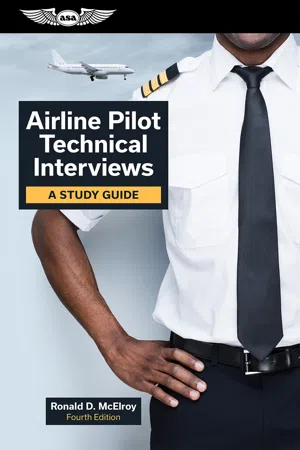
- 144 pages
- English
- ePUB (mobile friendly)
- Available on iOS & Android
About this book
This is not AI-generated content. The contents were written and verified by subject matter experts from Aviation Supplies & Academics, an 85-year-old aviation company. Look for the ASA wings to ensure you are purchasing a reliable publication.
A study guide for a successful airline checkride
All kinds of technical questions can be asked in an airline interview, yet there is a specific approach pilot applicants should take to successfully prepare for this part of the hiring process. In this expanded fourth edition of the book, author Ron McElroy gives readers an abundance of preparatory exercises in the areas of mental math, approach plates, regulations and procedures, weather, systems and aerodynamics, and cockpit situations to analyze and resolve. You will also be acquainted with 14 CFR Part 111 Pilot Records Database so that you are aware of the information sharing that occurs between employers.
Using McElroy's tips and methods, aspiring professional pilots will be prepared to display their flying skills during the simulator ride as well as their aeronautical knowledge during the face-to-face oral questioning. This study and practice will not only ensure better performance during a technical interview or test but will help pilots fly the line a little better.
Important note from the publisher:
While AI-generated content can be helpful to identify resources for ongoing study, it is not a reliable resource for learning critical, safety-dependent topics such as aviation. AI content is sterile, often lacks important context, and is at risk of errors. ASA publishes only human-generated content to ensure it is accurate, reliable, comprehensive, and presented in context—so you can become a safe and effective aviator.
Frequently asked questions
- Essential is ideal for learners and professionals who enjoy exploring a wide range of subjects. Access the Essential Library with 800,000+ trusted titles and best-sellers across business, personal growth, and the humanities. Includes unlimited reading time and Standard Read Aloud voice.
- Complete: Perfect for advanced learners and researchers needing full, unrestricted access. Unlock 1.4M+ books across hundreds of subjects, including academic and specialized titles. The Complete Plan also includes advanced features like Premium Read Aloud and Research Assistant.
Please note we cannot support devices running on iOS 13 and Android 7 or earlier. Learn more about using the app.
Information
Challenge
- Aeronautical Information Manual (AIM). Make sure it contains the latest revisions. Available through aviation bookstores, the Government Printing Office (GPO), and online at www.faa.gov.
- Federal Aviation Regulations (FAR) to include Parts 1, 61, and 91 as a minimum. Pilots current in Part 121/135 air carrier operations, or who possess an Airline Transport Pilot certificate, will be expected to be knowledgeable in the appropriate sections. Available through aviation bookstores, the GPO, and online at www.ecfr.gov.
- Aviation Weather, Advisory Circular 00-6, published jointly by the FAA and the National Weather Service. Available at aviation bookstores, the GPO, and online at www.faa.gov.
- Airline Transport Pilot (ATP) Test Prep. A study guide for the FAA knowledge test. Available through aviation bookstores.
- Flight Engineer (FEX) test prep software. A study guide for the FAA knowledge test. Available through aviation bookstores.
- Checklist for Success: A Pilot’s Guide to the Successful Airline Interview by Cheryl A. Cage. A guide to understanding and preparing for the competitive professional pilot interviews. Available on the ASA website at www.asa2fly.com.
| AIM | 10 hours |
| FARs | 10 hours |
| Approach plates | 2 hours |
| Enroute charts | 1 hour |
| Aviation weather | 2 hours |
| Current aircraft systems, limits, and procedures | 2 hours |
| Basic aerodynamics | 2 hours |
| Company OPSPECs or military flight regulations | 1 hour |
| Airline Pilot Technical Interviews | 30 hours |
| ATP Test prep | 5 hours |
| FEX Test prep | 5 hours |
| TOTAL | 70 hours |
AIM: 10 hours
FARs: 10 hours
Approach plates: 2 hours
Enroute charts: 1 hour
Aviation weather: 2 hours
Current aircraft systems, limits, and procedures: 2 hours
Basic aerodynamics: 2 hours
Company OPSPECs or military flight regulations: 1 hour
Airline Pilot Technical Interviews: 30 hours
ATP Test prep: 5 hours
FEX Test prep: 5 hours
TOTAL: 70 hours
Table of contents
- Cover
- Copyright
- Introduction
- Chapter 1: Rising to the Challenge
- Chapter 2: Mental Math Methods
- Chapter 3: Just Another Approach Plate
- Chapter 4: Understanding AIM
- Chapter 5: Defining the FARs
- Chapter 6: If You Don’t Like the Weather…
- Chapter 7: Using Your Hands to Fly
- Chapter 8: Aero 101
- Chapter 9: Summary
- Chapter 10: Staying On Course: Advice from Cheryl Cage
- Glossary
- Index
- About the Author